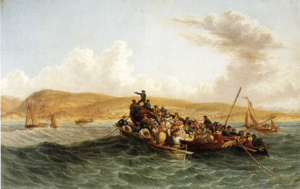1820 Settlers facts for kids
The 1820 Settlers were groups of people from the United Kingdom (England, Ireland, Scotland, and Wales). They were sent by the British government and the local authorities in the Cape Colony to live in the Eastern Cape part of South Africa in 1820. These settlers helped shape the history of the region.
Contents
Why the Settlers Came to South Africa
After a big war called the Napoleonic Wars, many people in Britain lost their jobs. There was a lot of unemployment. The government of the Cape Colony wanted to help these people. They also had another reason: they wanted to make the eastern border stronger against the nearby Xhosa peoples.
By sending British settlers, they hoped to create a buffer zone. This plan also aimed to increase the number of English-speaking people in South Africa. This led to the creation of Albany, South Africa, which became a main area for British people living in Africa.
Settling in a New Land
Many people wanted to become settlers. About 90,000 people applied, but only 19,000 were approved. Even fewer, about 4,000, could actually travel because there wasn't enough money for everyone.
Most of the 1820 Settlers arrived in the Cape between April and June 1820. They came in about 60 different groups. They were given farms near a village called Bathurst, Eastern Cape. They also received tools and food. However, many of them didn't know much about farming. Because of this, many settlers left their farms. They moved to towns like Bathurst, Grahamstown, East London, and Port Elizabeth. There, they went back to their old jobs, like being traders or craftspeople.
Settlers in Natal
Some of the 1820 Settlers traveled even further, moving to a place called Natal. At that time, Natal was part of Zululand, home to the powerful Zulu people. King Shaka ruled this land with his highly trained warriors.
The leaders of the Natal settlers asked King Shaka for permission to stay. When the king saw the settlers' advanced tools and weapons, he agreed. In return, he wanted access to their firearm technology. Some famous settlers who moved to Natal included John Bailie, who started East London, and Charles Kestell.
A Different Path for Some
Not all settlers had the same experience. Two ships arrived at the Cape of Good Hope from London, after stopping in Ireland. About 200 settlers on these ships stayed offshore for a week. Then, they were sailed to a different place called Saldanha.
From Saldanha, they were taken by carts to Clanwilliam. Here, they were given very small pieces of land. Most of these families were later moved to the Eastern Cape, where the other British settlers were. However, five families stayed behind. They were isolated from the other British settlers and soon became part of the Dutch/Afrikaans-speaking communities. Because of this, some of their English descendants later fought against the English in the Second Boer War.
Remembering the Settlers
The 1820 Settlers are remembered in Grahamstown. The 1820 Settlers National Monument was opened there in 1974. This monument is a special place. It hosts plays, music shows, and cultural events.
The 1820 Settlers Association supports the monument. This group was started in 1920 by Sir Walter Stanford and other descendants of the settlers. The association also tried to encourage more British people to move to South Africa.
Notable 1820 Settlers
- William Guybon Atherstone
- John Burnet Biddulph
- Alexander Biggar
- Henry Hare Dugmore
- George Henry Ford
- Robert Godlonton
- Dr. Edward Roberts, a surgeon who brought the printing press to South Africa.
- Jeremiah Goldswain, a farmer whose journal helps us understand how people spoke English in the 1800s.
- Richard Gush
- Dick King
- Joshua "Emperor" Norton
- Thomas Pringle
- Thomas Shone
- James Cotterell Hoole
See also
- 1820 Settlers National Monument
- Fort Frederick, Eastern Cape
- Second Boer War
- White Africans
- British diaspora in Africa



